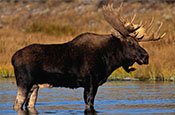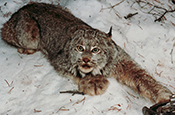Sixth Mass Extinction
Humans are responsible for habitat destruction, climate change, pollution, etc. to such an extent that a sixth mass extinction is now underway. Underlying all of the causes is our population growth.
Hunting
Many of the animals shot by hunters suffer for an extended period of time as they die slowly from blood loss, infection or starvation.
 Hunting for Trophies
Hunting for Trophies
Many if not most modern hunters and fishermen are “sportsmen” who kill animals only for “trophies.”
Captive-Animal Hunting
Captive hunts, which are also known as “canned hunts,” do not give animals a chance to escape. Shooters pay to kill animals — including members of endangered species — trapped within fences.
Internet Hunting
Internet hunting, which is also called remote-controlled hunting, allows computer users to kill animals confined within fences from home.
Nonlethal Wildlife Management
Nonlethal methods of preventing wildlife from becoming a nuisance, preying upon farm animals or otherwise coming into conflict with people are often more effective — and not even considered before action is taken.
Overfishing
More than 85 percent of the world’s fisheries have been pushed to or beyond their biological limits and are in need of strict management plans to restore them.
Derelict Fishing Gear
Derelict fishing gear, which is sometimes referred to as “ghost gear” or “ghost nets,” often continues to trap and kill animals long after being discarded.
Poaching
At current poaching rates, elephants, rhinoceroses and other wildlife may be gone from the wild within our lifetime.
Wildlife Trafficking
Wildlife crime involving the trafficking of wild animals and animal parts is conducted throughout the world and in many cases provides funding for terrorist activities.
 Trapping for Fur
Trapping for Fur
Numerous animals — raccoons, wolves, otters, nutria and others — are killed for clothing by trappers.
Zoos, Aquariums and Theme Parks
The vast majority of the wildlife exhibitors licensed by the United States government do not meet industry accreditation standards. This is especially true of the many roadside zoos and menageries.
Circuses
Circus animals stand on their heads, jump through rings of fire, ride bicycles, etc. because the animals are forced to do so — not because they want to do so.
Wildlife Tourism
Millions of people who visit tourist attractions involving wildlife each year are contributing to animal abuse.
Exotic Pets
Keeping wild animals as pets threatens public health and safety as well as animal welfare. Wild animals can attack people and spread disease and an average pet owner cannot provide the care the animals need in captivity.
Vehicular Collisions
Many collisions of cars, trucks, etc. with wildlife on roads can be prevented.
Aircraft Collisions
Many bird strikes and other collisions between airplanes and wildlife are avoidable.

